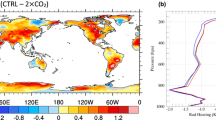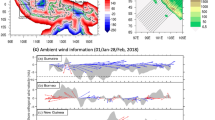Abstract
Two parallel sets of numerical experiments (an ozone-hole simulation and a non-ozone-hole simulation) were performed to investigate the effect of ozone depletion on surface temperature change using the second spectral version of the Flexible Global Ocean-Atmosphere-Land System model (FGOALS-s2), focusing on the eastern Antarctica (EA) continent in austral summer. First, we evaluated the ability of the model to simulate the EA surface cooling, and found the model can successfully reproduce the cooling trend of the EA surface, as well as the circulation change circling the South Pole in the past 30 years. Second, we compared the two experiments and discovered that the ozone depletion causes the cooling trend and strengthens the circumpolar westerly flow. We further investigated the causes of the EA surface cooling associated with the ozone hole and found two major contributors. The first is the ozone-hole direct radiation effect (DRE) upon the surface that happens because the decrease of the downward longwave (LW) radiation overcomes the increase of the downward shortwave (SW) radiation under clear sky. The second is the cloud radiation effect (CRE) induced by ozone depletion, which happens because the decreased downward SW radiation overcomes the increased downward LW radiation in the case of increased cloud. Although the CRE is theoretically opposite to the DRE, their final net effect makes comparable contributions to the EA surface cooling. Compared with the surface radiation budget, the surface heat flux budgets have a much smaller contribution. We additionally note that the CRE is basically ascribed to the circulation change.
Similar content being viewed by others
References
Bao, Q., G. X. Wu, Y. M. Liu, J. Yang, Z. Z. Wang, and T. J. Zhou, 2010: An introduction to the coupled model FGOALS1.1-s and its performance in East Asia. Adv. Atmos. Sci., 27, 1131–1142. doi: 10.1007/s00376-010-9177-1.
Bao, Q., and Coauthors, 2013: The flexible global oceanatmosphereland system model, spectral version 2: FGOALSs2. Adv. Atmos. Sci., 30, 561–576, doi: 10.1007/s00376-012-2113-9.
Barnes, E. A., and D. L. Hartmann, 2010: Dynamical feedbacks of the southern annular mode in winter and summer. J. Atmos. Sci., 67, 2320–2330.
Briegleb, B. P., C. M. Bitz, E. C. Hunke, W. H. Lipscomb, M. M. Holland, J. L. Schramm, and R. E. Moritz, 2004: Scientific description of the sea ice component in the community climate system model. 3rd version. NCAR Tech. Note, 70 pp.
Cordero, E. C., and P. M. Forster, 2006: Stratospheric variability and trends in models used for the IPCC AR4. Atmos. Chem. Phys., 6, 5369–5380.
Dee, D. P., and Coauthors, 2011: The ERA-Interim reanalysis: Configuration and performance of the data assimilation system. Quart. J. Roy. Meteor. Soc., 137 553–597.
Fogt, R. L., J. Perlwitz, and A. J. Monaghan, 2009: Historical SAM variability. Part II: Twentieth-century variability and trends from reconstructions, observations, and the IPCC AR4 Models. J. Climate, 22, 5346–5365.
Forster, P.M. D., and K. P. Shine, 1997: Radiative forcing and temperature trends from stratospheric ozone changes. J. Geophys. Res., 102, 10 841–10 855.
Gillett, N. P., and D. W. J. Thompson, 2003: Simulation of recent Southern hemisphere climate change. Science, 302, 273–275.
Grise, K. M., and D. W. J. Thompson, 2009: On the role of radiative processes in stratosphere-troposphere coupling. J. Climate, 22, 4154–4161.
Hu, Y., Y. Xia, and X. Fu, 2011: Tropospheric temperature response to stratospheric ozone recovery in the 21st century. Atmos. Chem. Phy., 11, 7687–7699.
Kiehl, J. T., and P. R. Gent, 2004: The community climate system model, version 2. J. Climate, 17, 3666–3682.
Lal, M., A. K. Jain, and M. C. Sinha, 1987: Possible climatic implications of depletion of Antarctic ozone. Tellus, 38, 326–328.
Liu, H. L., Y. Q. Yu, W. Li, and X. H. Zhang, 2004: Manual for LASG/IAP Climate System Ocean Model (LICOM1. 0). Science Press, Beijing, 128 pp. (in Chinese)
Liu, H. L., P. F. Lin, Y. Q. Yu, and X. H. Zhang, 2012: The baseline evaluation of LASG/IAP climate system ocean model (LICOM) version 2. Acta Meteorologica Sinica, 26, 318–329, doi: 10.1007/s13351-012-0305-y.
Marshall G. J., A. Orr, N. P. M. van Lipzig, and J. C. King, 2006: The impact of a changing Southern Hemisphere annular mode on Antarctic Peninsula summer temperatures. J. Climate, 19, 5388–5404.
Marshall, G. J., D. B. Stefano, and S. S. Naik, 2011: Analysis of a regional change in the sign of the SAM-temperature relationship in Antarctica. Climate Dyn., 36, 277–287.
Monaghan, A. J., D. H. Bromwich, H. David, and W. Chapman, 2008: Recent variability and trends of Antarctic nearsurface temperature. J. Geophys. Res., 113, D04105, doi: 10.1029/2007JD009094.
Polvani, L. M., W. W. Darryn, J. P. Gustavo, and S. W. Son, 2011: Stratospheric ozone depletion: The main driver of twentiethcentury atmospheric circulation changes in the Southern Hemisphere. J. Climate, 24, 795–812.
Previdi, M., and L. M. Polvani, 2011: Comment on “Tropospheric temperature response to stratospheric ozone recovery in the 21st century” by Hu et al. (2011). Atmos. Chem. Phys., 12, 4893–4896.
Qu, X., A. Hall, and B. Julien, 2012: Why does the Antarctic Peninsula warm in climate simulations? Climate Dyn., 38, 913–927.
Ramanathan, V., and R. E. Dickinson, 1979: The role of stratospheric ozone in the zonal and seasonal radiative energy balance of the earth-troposphere system. J. Atmos. Sci., 36, 1084–1104.
Ramaswamy, V., and Coauthors, 2001: Stratospheric temperature trends: Observations and model simulations. Rev. Geophys., 39, 71–122, doi: 10.1029/1999RG000065.
Randel, W. J., and F. Wu, 2007: A stratospheric ozone profile data set for 1979–2005: Variability, trend and comparison with column ozone data. J. Geophys. Res., 112, D06313 doi: 10.1029/2006JD007339.
Screen, J. A., and I. Simmonds, 2012: Half-century air temperature change above Antarctica: Observed trends and spatial reconstructions. J. Geophys. Res., D16108, doi: 10.1029/2012JD017885.
Shindell, D. T., and G. A. Schmidt, 2004: Southern Hemisphere climate response to ozone changes and greenhouse gas increases. Geophys. Res. Lett., 31, L18209, doi: 10.1029/2004GL020724.
Solomon, S., 1999: Stratospheric ozone depletion: A review of concepts and history. Rev. Geophys., 37, 275–316. doi: 10.1029/1999RG900008.
Taylor, K. E., R. J. Stouffer, and G. A. Meehl, 2012: An overview of CMIP5 and the experiment design. Bull. Amer. Meteor. Soc., 93, 485–498.
Thompson, D. W. J., and S. Solomon, 2002: Interpretation of recent Southern Hemisphere climate change. Science, 296, 895–899.
Thompson, D. W. J., J. M. Wallace, and G. C. Hegerl, 2000: Annular modes in the extratropical circulation. Part II: Trends. J. Climate, 13, 1018–1036.
Thompson, D. W. J., S. Solomon, P. J. Kushner, M. H. England, K. M. Grise, and D. J. Karoly, 2011: Signatures of the Antarctic ozone hole in Southern Hemisphere surface climate change. Nature Geoscience, 4, 741–749.
Wang, W.-C., Y. C. Zhuang, and R. D. Uojkov, 1993: Climate implications of observed changes in ozone vertical distributions at middle and high latitudes of the northern hemisphere Geophys. Res. Lett., 20, 1567–1570, doi: 10.1029/93GL01318.
World Meteorological Organization (WMO), 2007: Scientific assessment of ozone depletion, 2006. WMO Global Ozone Research and Monitoring Project Rep. No. 50, Geneva, 572 pp.
Wood, R, B. Huebert, C. R. Mechoso, and R. Weller, 2007: The VAMOS Ocean-Cloud-Atmosphere-Land study. WCRP and Cosponsors Program Summary, 9 pp. [Available online at http://www.eol.ucar.edu/projects/vocals/documentation/vocalsoverview.pdf.]
Author information
Authors and Affiliations
Corresponding author
Rights and permissions
About this article
Cite this article
Yang, J., Bao, Q., Ji, D. et al. Simulation and causes of eastern Antarctica surface cooling related to ozone depletion during austral summer in FGOALS-s2. Adv. Atmos. Sci. 31, 1147–1156 (2014). https://doi.org/10.1007/s00376-014-3144-1
Received:
Revised:
Accepted:
Published:
Issue Date:
DOI: https://doi.org/10.1007/s00376-014-3144-1




